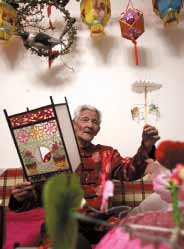Lantern maker Zhang Mingliang has many secrets to tell about the Forbidden
City. The stories, together with his lantern making skills, were passed on by
his master, Dong Shihui, a eunuch who lived in the imperial palace.
"There is another name for red gauze lanterns in the Forbidden City," said
Zhang, who is now 74 years old. "They are known as qisifeng deng (meaning
lanterns that make the wind mad)."
"In order to please royal family members, eunuchs had to make up many
auspicious sayings. The name and description of various lanterns is vivid proof
of that," he said. Zhang showed off a thin, gauze-coated lantern, framed with 24
curved bamboo strips, which is meant to bring the owner prosperity for the whole
year. He explained that the braid at the bottom of the lantern symbolizes peace.
 Zhang first started to learn the art of making palace lanterns from the age
of seven. After the Qing Dynasty (1644-1911) ended, the eunuchs were expelled
from the imperial palace. Without a job, Zhang's eunuch master survived by
collecting trash and making lanterns.
Zhang first started to learn the art of making palace lanterns from the age
of seven. After the Qing Dynasty (1644-1911) ended, the eunuchs were expelled
from the imperial palace. Without a job, Zhang's eunuch master survived by
collecting trash and making lanterns.
"The poor Dong lived next to my home near Dongsi area since 1930s," recalled
Zhang. "My kind-hearted mother asked me to help our special neighbour."
Zhang was excited and proud about helping the eunuch earn money by making and
selling lanterns. And his enthusiasm paid off the lanterns were so popular that
he dropped out of school and made lantern making his career.
Over the last 67 years, Zhang has made hundreds of different types of
lanterns from palace lanterns and lanterns with revolving figures to gauze
lanterns and wall lanterns.
His home is a world of colour, filled with lanterns that hang from the
ceilings and walls.
Among the collection is a lantern called zouma deng, (horse walking lantern),
which has images that move across it. The lanterns look like pretty paper
pavilions with upturned eaves and corners. Inside there is a wire frame fastened
at the centre to a vertical shaft pasted with paper vanes, on which a group of
figures stand. Propelled by the heated air from the lit candle, the shaft and
vanes move, turning the frame and making the figures dance across the paper.
The pictures depict old Beijingers from all walks of life such as fruit
sellers, barbers and knife polishers.
Zhang used to sell his lanterns at temple fairs. "The amount of money we got
at temple fairs not only depended on our lanterns, but also on our ability to
hawk and attract customers," said Zhang, who turned hawking into an art form by
singing different songs about his numerous lanterns.
Lanterns originated from the white paper lights used as signals during
battles. Later lanterns were made red and only lit for emperors in the Han
Dynasty (206BC-220AD) and then they were gradually introduced into regular
households.
As well as the major Lantern Festival held on the fifteenth day of the first
month on the Chinese lunar calendar, there are a number of other lantern
festivals held throughout the year. On the fifteenth day of the seventh lunar
month, for instance, people gather near Shichahai Lake to light lotus-shaped
lanterns and sail them on the water to remember their forefathers. According to
Chinese tradition, such lanterns should be destroyed and abandoned after the
ceremony.
"People would burn their lanterns in a giant, hollow copper Buddha, over 60
metres high, set between the Drum and Bell towers," said Zhang. "Thick smoke
could even been seen from the top of the Fragrant Hills in west Beijing."
Lantern making combines the skills of a carpenter, painter, potter and
weaver. Zhang's lanterns became famous for combining all these skills.
The talented pensioner can also make shapes like flower baskets, animals,
vegetables and buildings by using all different materials from bamboo, rosewood
to iron.
He continues to use the traditional technique of "fine brushwork" to draw
characters and scenes from legends and history onto the lanterns, giving them a
dazzling brilliance.
A pair of "birds" that nod to each other on one lantern, and a lantern that
rolls along the ground without being burnt by the lit candle inside are two of
his signature works.
Some of Zhang's works are currently on display at the Culture Palace of
Nationalities Museum. His lanterns have even been printed on stamps and he is
often invited to lecture on lantern making to young students and foreign
diplomats. He used to have stores at Beijing Lufthansa Centre and Wangfujing,
but too overloaded with orders, he shut up shop to concentrate on simply making
lanterns only.
Zhang can make a regular lantern in less than 3 hours, which he will then
sell for at least 100 yuan.
The problem he faces now is ensuring that his traditional lantern making
skills are handed down to the next generation.
He currently has just one apprentice, aged 51. They are busy making several
hundred lanterns in a studio to meet the annual demand from exhibition centres
and hotels.
"It's a modest discipline," he said with a smile. "I like to think that I'm
just a small lantern maker who makes others feel happy."
(China Daily 01/04/2007 page16)